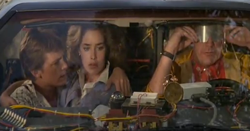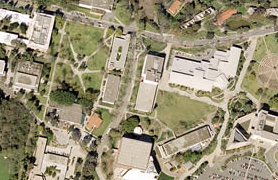 The title is a reference to the final scene of one of the radest 80’s movies ever: “Back to the Future.” I remember walking out of that theater as a kid hopped up on red vines, Huey Lewis, the prospect of time travel, and all the possibility that a flying delorean represented. It seemed like anything was possible.
The title is a reference to the final scene of one of the radest 80’s movies ever: “Back to the Future.” I remember walking out of that theater as a kid hopped up on red vines, Huey Lewis, the prospect of time travel, and all the possibility that a flying delorean represented. It seemed like anything was possible.
I have a similar optimism today with this swirling curling storm of a revolution that’s promising to change how products will be test marketed, built and delivered. I predict this fundamental change is going to do for product development and business model generation what test-driven development did for software dev. And it’s pretty freakin’ exciting to be swimming in this stew of startup activity while this storm is developing. To explain the essence of this mentality let me first tell a story that will reveal a double entendre in this post’s title:
 I don’t have the original source on this anecdote but supposedly at a California college (Cal Poly?) they were redesigning the campus and trying to figure out where to build the new sidewalks. It was a complex arrangement of buildings and there were a bunch of conflicting opinions about where the sidewalks belonged. Someone had the ingenious idea that rather than speculating, they should instead run an experiment and let the market speak. So they planted grass the first year and waited. At the end of the year they took an aerial photo and the tread-worn ground became the blueprint for the optimal sidewalk routes as chosen perfectly and implicitly by the student body.
I don’t have the original source on this anecdote but supposedly at a California college (Cal Poly?) they were redesigning the campus and trying to figure out where to build the new sidewalks. It was a complex arrangement of buildings and there were a bunch of conflicting opinions about where the sidewalks belonged. Someone had the ingenious idea that rather than speculating, they should instead run an experiment and let the market speak. So they planted grass the first year and waited. At the end of the year they took an aerial photo and the tread-worn ground became the blueprint for the optimal sidewalk routes as chosen perfectly and implicitly by the student body.
So what does this have to do with startups?
I believe we’re on the cusp of seeing some major changes in how products are brought to market. If you follow the Lean Startup, Four Steps to the Epiphany, Customer Development movements then you have the core philosophy already. But what’s interesting is the emergence of tools that allow you to apply these concepts very rapidly on a large and targeted scale via online experiments. We in the tech industry no longer have to build and tear up sidewalks – we can just plant grass first. Rather than explain the techniques for “virtual grass planting,” I figure it will be easier to simply publish the data and methods for experiments I’m conducting now with a local Phoenix startup that I advise. Here’s the gist of it though:
You can think of this mentality like test-driven development for business.
Test-driven development (TDD) is a methodology for creating software where you seemingly put the cart before the horse and write the tests up front. You then go back and do the necessary coding to satisfy the tests. Once the code meets the test, then (and only then) do you go back and fine-tune, refactor and optimize things. Having been a confessed “cowboy coder” back in the day this style of development sounded completely absurd until I saw it in practice at the San Diego Java User Group. Writing the tests first forces you to think differently by getting consensus on the destination and then worrying about the implementation details of how you get there after the fact. In the same way it’s now possible with all these tools to front-load much of the learning about product-market fit, price elasticity & messaging before you ever actually do an ounce of engineering. It’s all about systematically removing uncertainty and converting unknowns to knowns before charging ahead with the concrete.
Anyways, I don’t mean to leave anyone with startup blue balls but we’re not quite ready at this point to open source our experiments. This is an exciting time to be in this space though. To get a good flavor for this type of thinking check out Kent Beck’s talk from the Startup Lessons Learned conference on the logical extension of Agile development to business. And if you’re new here sub the RSS of this feed or this Twitter account to follow along on how we’re validating and iterating at 88mph and 1.21 gigawatts.







